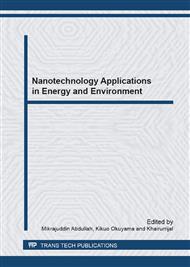p.137
p.145
p.153
p.159
p.166
p.176
p.183
p.191
p.197
PVA-Ketoprofen Nanofibers Manufacturing Using Electrospinning Method for Dissolution Improvement of Ketoprofen
Abstract:
Background and purpose: Ketoprofen is an NSAIDs agent which has analgesic and anti inflammation effects. Ketoprofen is classified into class II in the biopharmaceutical classification system that has a high permeability but low solubility. Hence, the absorption rate of this substance is governed by its dissolution rate. Electrospinning is a method that combine solid dispersion technology and nanotechnology. This method can be selected to enhance the dissolution rate of active substances. The aim of this research is to improve the dissolution rate of ketoprofen through the preparation of polymeric nanofiber polivinyl alcohol (PVA) containing ketoprofen using electrospinning process. Methods: Preparation of nanofibers with various of PVA-ketoprofen ratio, flow rate, and PVA concentration in the solution were accomplished using electrospinning instrument. Casting solid dispersion film were also prepared by solvent evaporation method and used as a reference. The rates of dissolution of ketoprofen from each of nanofibers, casting films, and pure ketoprofen were conducted in HCl pH 1.2 medium at 37oC. Characterization of nanofibers was carried out using Scanning Electron Microscope (SEM) and X-ray Diffraction (XRD). Results: Nanofibers which contained of PVA-ketoprofen 1:1 in ratio w/w showed a significant improvement in dissolution (p<0.05) compared to the pure ketoprofen. Meanwhile, nanofibers obtained from a solution containing 7.5 % PVA (w/v) and 4 ml/h in flow rate showed the best dissolution rate improvement and significantly different (p<0.05) with either the casting film or the pure ketoprofen. The improvement of ketoprofen dissolution was due to the increasing of surface area of nanofiber and the change of ketoprofen from crystalline into amorphous form. Conclusion: Electrospinning technique can be used to improve the dissolution rate of ketoprofen through the PVA-ketoprofen nanofiber formation by choosing the appropriate polymer concentration and manufacturing process.
Info:
Periodical:
Pages:
166-175
Citation:
Online since:
January 2013
Keywords:
Price:
Сopyright:
© 2013 Trans Tech Publications Ltd. All Rights Reserved
Share:
Citation:


